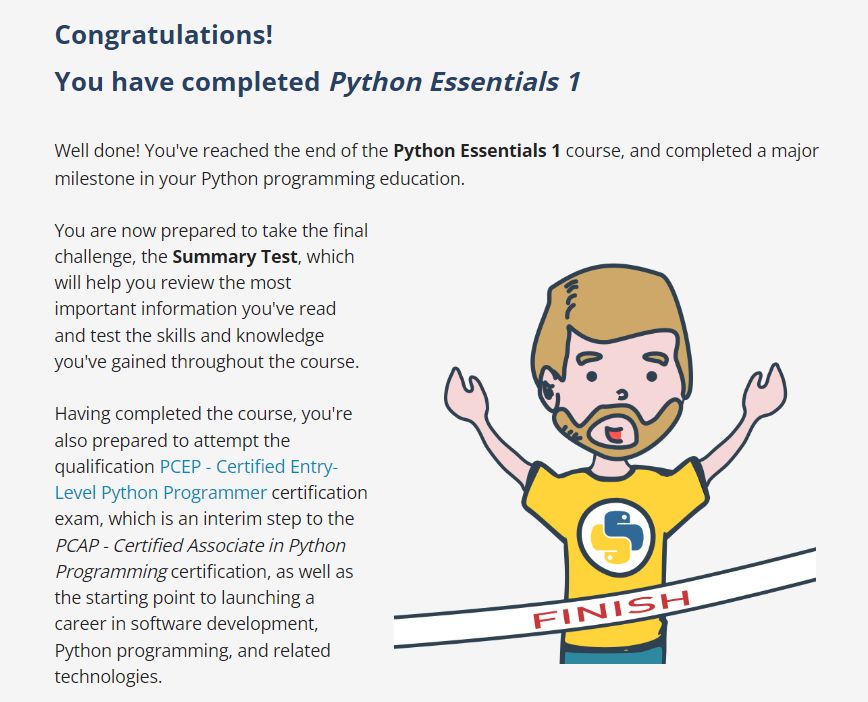These are my notes, code, solutions and resources used to prepare for the PCAP -Certified Entry-Level Python Programmer certification (Exam PCAP-30-02)-EXAM.
information and exercises are based on the official PCAP-30-02 Exam sudy syllabus and course!
PCEP™ – Certified Entry-Level Python Programmer certification shows that the individual is familiar with universal computer programming concepts like data types, containers, functions, conditions, loops, as well as Python programming language syntax, semantics, and the runtime environment.
PCEP™ – Certified Entry-Level Python Programmer certification (Exam PCEP-30-0x) is a professional credential that measures the candidate's ability to accomplish coding tasks related to the essentials of programming in the Python language. A test candidate should demonstrate sufficient knowledge of the universal concepts of computer programming, the syntax and semantics of the Python language, as well as the skills in resolving typical implementation challenges with the help of the Python Standard Library.
The PCEP™ certification shows that the individual is familiar with the following concepts: fundamental terms and definitions (e.g. compilation vs. interpretation), Python's logic and structure (e.g. keywords, instructions, indentation), literals, variables, and numeral systems, operators and data types, I/O operations, control flow mechanisms (conditional blocks and loops), data collections (lists, tuples, dictionaries, strings), functions (decomposition, built-in and user-defined functions, organizing interaction between functions and their environment, generators, recursion), exceptions (exception handling, hierarchies), as well as the essentials of Python programming language syntax, semantics, and the runtime environment.
The exam consists of four sections:
- Section 1 -> 7 items, 18%
- Section 2 -> 8 items, 29%
- Section 3 -> 7 items, 25%
- Section 4 -> 8 items, 28%
- Computer Programming and python fundamentals - 18%
- PCEP-30-02 1.1 – Understand fundamental terms and definitions
- interpreting and the interpreter
- compilation and the compiler
- lexis, syntax, and semantics
- PCEP-30-02 1.2 – Understand Python’s logic and structure
- keywords
- instructions
- indentation
- comments
- PCEP-30-02 1.3 – Introduce literals and variables into code and use different numeral systems
- Boolean, integers, floating-point numbers
- scientific notation
- strings
- binary, octal, decimal, and hexadecimal numeral systems
- variables
- naming conventions
- implementing PEP-8 recommendations
- PCEP-30-02 1.4 – Choose operators and data types adequate to the problem
- numeric operators: ** * / % // + –
- string operators: * +
- assignment and shortcut operators
- unary and binary operators
- priorities and binding
- bitwise operators: ~ & ^ | << >>
- Boolean operators: not, and, or
- Boolean expressions
- relational operators ( == != > >= < <= )
- the accuracy of floating-point numbers
- type casting
- PCEP-30-02 1.5 – Perform Input/Output console operations
- the print() and input() functions
- the sep= and end= keyword parameters
- the int() and float() functions
- PCEP-30-02 1.1 – Understand fundamental terms and definitions
- Control flow - conditional blocks and loops - 29%
- PCEP-30-02 2.1 – Make decisions and branch the flow with the if instruction
- conditional statements: if, if-else, if-elif, if-elif-else
- multiple conditional statements
- nesting conditional statements
- PCEP-30-02 2.2 – Perform different types of iterations
- the pass instruction
- building loops with while, for, range(), and in
- iterating through sequences
- expanding loops with while-else and for-else
- nesting loops and conditional statements
- controlling loop execution with break and continue
- PCEP-30-02 2.1 – Make decisions and branch the flow with the if instruction
- Data collections, tuples, dictionaries, lists, and strings - 25%
- PCEP-30-02 3.1 – Collect and process data using lists
- constructing vectors
- indexing and slicing
- the len() function
- list methods: append(), insert(), index(), etc.
- functions: len(), sorted()
- the del instruction
- iterating through lists with the for loop
- initializing loops
- the in and not in operators
- list comprehensions
- copying and cloning
- lists in lists: matrices and cubes
- PCEP-30-02 3.2 – Collect and process data using tuples
- tuples: indexing, slicing, building, immutability
- tuples vs. lists: similarities and differences
- lists inside tuples and tuples inside lists
- PCEP-30-02 3.3 Collect and process data using dictionaries
- dictionaries: building, indexing, adding and removing keys
- iterating through dictionaries and their keys and values
- checking the existence of keys
- methods: keys(), items(), and values()
- PCEP-30-02 3.4 Operate with strings
- constructing strings
- indexing, slicing, immutability
- escaping using the \ character
- quotes and apostrophes inside strings
- multi-line strings
- basic string functions and methods
- PCEP-30-02 3.1 – Collect and process data using lists
- Functions and exceptions - 28%
- PCEP-30-02 4.1 – Decompose the code using functions
- defining and invoking user-defined functions and generators
- the return keyword, returning results
- the None keyword
- recursion
- PCEP-30-02 4.2 – Organize interaction between the function and its environment
- parameters vs. arguments
- positional, keyword, and mixed argument passing
- default parameter values
- name scopes, name hiding (shadowing), and the global keyword
- PCEP-30-02 4.3 – Python Built-In Exceptions Hierarchy
- BaseException
- Exception
- SystemExit
- KeyboardInterrupt
- abstract exceptions
- ArithmeticError
- LookupError
- IndexError
- KeyError
- TypeError
- ValueError
- PCEP-30-02 4.4 – Basics of Python Exception Handling
- try-except / the try-except Exception
- ordering the except branches
- propagating exceptions through function boundaries
- delegating responsibility for handling exceptions
- PCEP-30-02 4.1 – Decompose the code using functions




